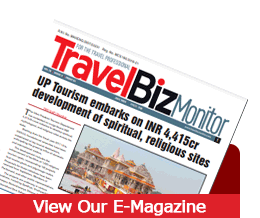Inept handling of Covid-19 cases especially in the second wave, has dented the image of India as a tourist destination. In order to instill confidence among the foreign travellers to visit India immediately after border re-opens , it is essential to redefine Incredible India campaign. Currently, tourism branding is centered around the arenas of culture and festivals which is synonymous with crowds, writes Prasenjit Chakraborty.
There is a constant demand from stakeholders of the industry to start scheduled international flights. Not only that, they often say that many countries have opened their borders for fully vaccinated travellers (of course with tough measures) and India should follow the same. But it is imperative to think how foreign tourists perceive India as a safe destination after the onset of Covid-19. Interestingly, many players in the industry off the record admit that inbound business in all probability will continue to face rough weather unless drastic steps are taken by the government. Taking the pandemic situation in mind, it is no longer going to be business as usual in the tourism industry especially in the inbound sector where “perception” matters. Before opening borders or inviting foreign tourists to visit the country, India needs to do its homework perfectly.
Subhash Motwani, Director, Namaste Tourism, believes that government needs to imbibe confidence for the inbound sector by ensuring that there is clarity in terms of processes and SOPs to welcome tourists from overseas which would include clarity in quarantine rules and PCR tests. “Besides this, the government should spell out clearly which vaccines are valid for travel and should also design an user-friendly app for the incoming tourists. The Cowin App is confined for Indians to travel within India and not for incoming tourists,” points out Motwani.

For Debjit Dutta, Director & CEO, Impression Tourism Services (India) Pvt. Ltd, the pandemic has offered a chance to the industry for course correction. Since tourism has changed and certainly coming back in a very different shape and form, it is high time for the industry to understand the transformation and adapt to that. “The demand in the inbound business may be quite different considering the change in the tourist’s aptitude hence it is very important that we re-invent our products to sustain in business,”exhorts Dutta. He believes that responsible travel is the future of tourism, hence, industry needs to focus more on sustainable tourism products and practices in the days to come.
Time to rejig Incredible India campaign
Besides focusing on safety, hygiene, quarantine rule etc the incredible India campaign needs to be rejigged. Experts believe that there is a need to relook at the incredible India campaign. This is because branding has always been complimenting India’s cultural side which is synonymous with the crowd. If it continues (branding) the same way it would be detrimental for the inbound sector, taking the ongoing situation in mind.

Do you think it is time to emphasize on natural heritage as well? “Absolutely, yes,” said Vaibhav Kala, Founder & Director, Aquaterra Adventures. He adds, “India’s campaign in the post Covid19 era should focus on our incredible natural heritage, vast open spaces, forests, deserts, coastlines and mountains. These will be the new destinations, and attract visitors due to the sheer natural beauty, and away from the pre-pandemic thrust areas of our culture, and the colour and magic of our cities, which remains for a more stable time.”
Motwani too believes that the Incredible India campaign and plan need to be redefined. He said that there has to be emphasis on off beat trails, experiences that include nature, wildlife, wellness, yoga , serenity and the outdoors rather than festivals and events that encourage crowds and large gatherings.
According to Dutta, Incredible India is perhaps one of the most successful campaigns ever, the dynamic version of the campaign which was initiated in 2017 was also super effective. “But I strongly believe that now after the pandemic, it is time for Incredible India Version 3 to focus on region-specific positioning campaigns highlighting places over faces, women empowerment over woman safety, and sustainable tourism practices over-responsible tourism policy,” he pointed out. The idea is not only to enhance traffic but to evenly distribute the incoming traffic across all four regions of the country comprising both first-time and repeat travellers. “We may also need to think about redesign our future marketing initiatives to make them more result-oriented and meaningful,” Dutta exhorts.
Highlighting culture and festivals may not be effective in attracting visitors against the backdrop of the pandemic in the coming few years.
Free Visa a right move?
The government has already announced that the first five lakh foreign tourists will be issued visas free of cost, in an attempt to revive the tourism, hospitality and aviation sectors. Is it the right move? Or Will it really revive the sector? The reactions from the stakeholders are a mixed bag.

Motwani opines that the Ministry of Tourism instead of focusing on the number game of getting the first five lakh tourists into India should rather focus on segment strategies. Citing an example, he said, “The European tourists could be assigned to explore North of India, the American the West of India, the tourists from the African continent to focus on Central India for instance and to add to that one or two metro cities at the most.” This way traffic could split and would be easier to monitor in case there is a drastic increase in numbers which is essential in the current situation.
For Dutta, it’s a good initiative by the government and sends a positive message across the world. However, he suggests that the facility should be extended further. “I think the facility should be extended till the end of 2022 for the fully vaccinated travellers to make it more result-oriented,” opines Dutta. Kala feels that offering a free visa is not the right move. “In my opinion it may be unnecessary. Rather, the government should allow fully vaccinated people to visit India immediately, it could help revive the 2021 fall-winter season,” he points out.
In the backdrop of the Covid-19 situation, positioning India as a safe country is utmost essential. In this direction growth in domestic tourism will also play an important role. This is because foreign travellers before visiting India will definitely assess the domestic tourism scenario. Increase in domestic tourism is the first indication or impression for any country that it is coming back to normal. Since tourism is reopening with domestic travellers, the face of happy travellers in the backdrop of iconic landmarks need to be circulated continuously across the globe to convey that India is coming back to normal. Besides this, the massive vaccination drives especially for the industry stakeholders need to be also highlighted. Contactless check-in options at airports, hotels, etc would also go a long way in instilling confidence of the travellers.


